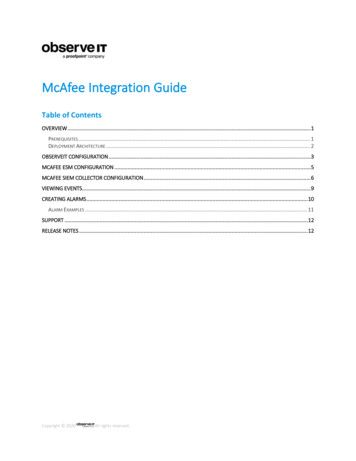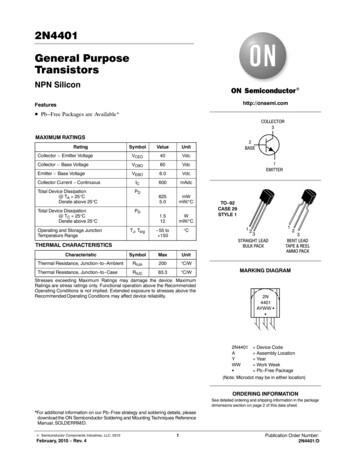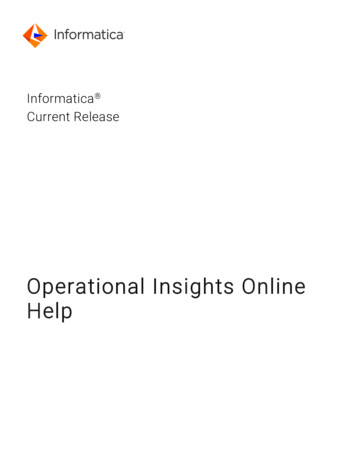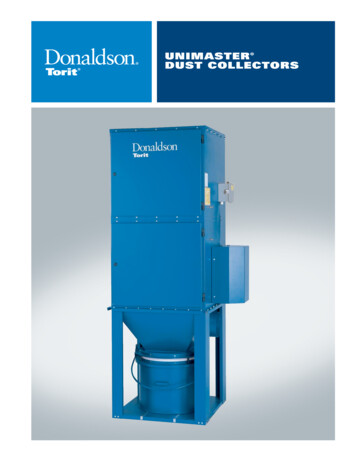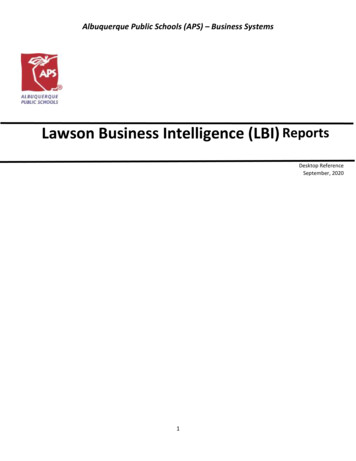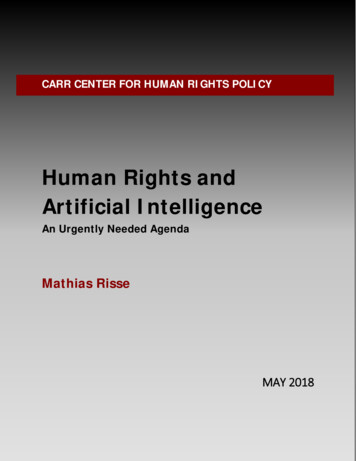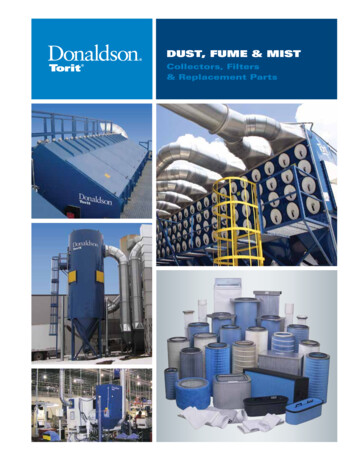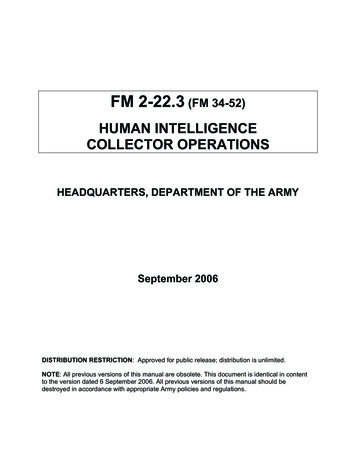
Transcription
FM 2-22.3 (FM 34-52)HUMAN INTELLIGENCECOLLECTOR OPERATIONSHEADQUARTERS, DEPARTMENT OF THE ARMYSeptember 2006DISTRIBUTION RESTRICTION: Approved for public release; distribution is unlimited.NOTE: All previous versions of this manual are obsolete. This document is identical in contentto the version dated 6 September 2006. All previous versions of this manual should bedestroyed in accordance with appropriate Army policies and regulations.
This publication is available atArmy Knowledge Online (www.us.army.mil) andGeneral Dennis J. Reimer Training and DoctrineDigital Library at (www.train.army.mil).
*FM 2-22.3 (FM 34-52)HeadquartersDepartment of the ArmyWashington, DC, 6 September 2006Field ManualNo. 2-22.3Human Intelligence Collector OperationsContentsPagePREFACE . viPART ONEHUMINT SUPPORT, PLANNING, AND MANAGEMENTChapter 1INTRODUCTION.1-1Intelligence Battlefield Operating System .1-1Intelligence Process .1-1Human Intelligence .1-4HUMINT Source.1-4HUMINT Collection and Related Activities .1-7Traits of a HUMINT Collector.1-10Required Areas of Knowledge .1-12Capabilities and Limitations .1-13Chapter 2HUMAN INTELLIGENCE STRUCTURE .2-1Organization and Structure .2-1HUMINT Control Organizations .2-2HUMINT Analysis and Production Organizations .2-6DISTRIBUTION RESTRICTION: Approved for public release; distribution is unlimited.NOTE: All previous versions of this manual are obsolete. This document is identical in content to the versiondated 6 September 2006. All previous versions of this manual should be destroyed in accordance withappropriate Army policies and regulations.*This publication supersedes FM 34-52, 28 September 1992, and ST 2-22.7, Tactical Human Intelligence andCounterintelligence Operations, April 2002.6 September 2006FM 2-22.3i
FM 2-22.3Chapter 3HUMINT IN SUPPORT OF ARMY OPERATIONS . 3-1Offensive Operations. 3-1Defensive Operations . 3-2Stability and Reconstruction Operations . 3-3Civil Support Operations. 3-7Military Operations in Urban Environment. 3-8HUMINT Collection Environments. 3-8EAC HUMINT . 3-9Joint, Combined, and DOD HUMINT Organizations . 3-10Chapter 4HUMINT OPERATIONS PLANNING AND MANAGEMENT. 4-1HUMINT and the Operations Process. 4-1HUMINT Command and Control . 4-3Technical Control. 4-4Command and Support Relationships. 4-4HUMINT Requirements Management . 4-5HUMINT Mission Planning . 4-15Task Organization . 4-18Operational Considerations . 4-19Operations Plans, Operations Orders, and Annexes . 4-21Operational Coordination. 4-22PART TWOHUMINT COLLECTION IN MILITARY SOURCE OPERATIONSChapter 5HUMINT COLLECTION . 5-1HUMINT Collection Operations . 5-1Human Source Contact Operations . 5-2Debriefing Operations. 5-7Liaison Operations. 5-12Interrogation Operations. 5-13Types of Interrogation Operations. 5-27PART THREE THE HUMINT COLLECTION PROCESSChapter 6SCREENING . 6-1Human Source Screening . 6-1Screening Operations. 6-2Screening Process . 6-9Screening Methodologies . 6-11Screening Requirements . 6-126 September 2006FM 2-22.3ii
FM 2-22.3Initial Data and Observations.6-13Source Assessment .6-14Other Types of Screening Operations .6-15Chapter 7PLANNING AND PREPARATION .7-1Collection Objectives.7-1Research .7-1HUMINT Collection Plan .7-8Final Preparations .7-13Chapter 8APPROACH TECHNIQUES AND TERMINATION STRATEGIES.8-1Approach Phase.8-1Developing Rapport .8-3Approach Techniques .8-6Approach Strategies for Interrogation .8-20Approach Strategies for Debriefing.8-21Approach Strategies for Elicitation.8-22Termination Phase .8-23Chapter 9QUESTIONING .9-1General Questioning Principles .9-1Direct Questions.9-1Elicitation .9-5Leads.9-5Detecting Deceit.9-6HUMINT Collection Aids .9-9Recording Techniques .9-9Questioning With an Analyst or a Technical Expert.9-11Third-Party Official and Hearsay Information.9-12Conducting Map Tracking .9-13Special Source Categories .9-16Chapter 10REPORTING .10-1Reporting Principles .10-1Report Types.10-1Reporting Architecture .10-56 September 2006FM 2-22.3iii
FM 2-22.3Chapter 11HUMINT COLLECTION WITH AN INTERPRETER . 11-1Advantages and Disadvantages of Interpreter Use . 11-1Methods of Interpreter Use. 11-2Sources of Interpreters . 11-4Interpretation Techniques. 11-5Training and Briefing the Interpreter. 11-5Placement of the Interpreter . 11-6Interactions With and Correction of the Interpreter . 11-7Interpreter Support in Report Writing . 11-8Evaluating the Interpreter . 11-8Managing an Interpreter Program . 11-9PART FOURANALYSIS AND TOOLSChapter 12HUMINT ANALYSIS AND PRODUCTION . 12-1Analytical Support to Operational Planning. 12-1Operational Analysis and Assessment. 12-3Source Analysis . 12-4Single-Discipline HUMINT Analysis and Production . 12-4HUMINT Source Selection . 12-19Chapter 13AUTOMATION AND COMMUNICATION. 13-1Automation. 13-1Collection Support Automation Requirements . 13-2Analytical Automation Requirements . 13-3Automation Systems. 13-7Communications . 13-8APPENDIX AGENEVA CONVENTIONS .A-1Section I. Geneva Conventions Relative to the Treatmentof Prisoners of War (Third Geneva Convention) .A-1Section II. Geneva Conventions Relative to the Protection ofCivilian Persons in Time of War (Fourth Geneva Convention) .A-47APPENDIX BSOURCE AND INFORMATION RELIABILITY MATRIX.B-1APPENDIX CPRE-DEPLOYMENT PLANNING . C-1APPENDIX DS2 GUIDE FOR HANDLING DETAINEES, CAPTURED ENEMY DOCUMENTS,AND CAPTURED ENEMY EQUIPMENT. D-16 September 2006FM 2-22.3iv
FM 2-22.3APPENDIX EEXTRACTS FROM ALLIED JOINT PUBLICATION (AJP)-2.5 . E-1APPENDIX FNATO SYSTEM OF ALLOCATING INTERROGATION SERIAL NUMBERS . F-1APPENDIX GQUESTIONING QUICK REFERENCE .G-1APPENDIX HSALUTE REPORTING . H-1APPENDIX IDOCUMENT EXPLOITATION AND HANDLING.I-1APPENDIX JREFERENCES.J-1APPENDIX KCONTRACT INTERROGATORS . K-1APPENDIX LSAMPLE EQUIPMENT FOR HCT OPERATIONS.L-1APPENDIX MRESTRICTED INTERROGATION TECHNIQUE - SEPARATION .M-1GLOSSARY . Glossary-1BIBLIOGRAPHY.Bibliography-1INDEX .Index-16 September 2006FM 2-22.3v
FM 2-22.3PrefaceThis manual provides doctrinal guidance, techniques, and procedures governing theemployment of human intelligence (HUMINT) collection and analytical assets insupport of the commander’s intelligence needs. It outlines HUMINT operations. The HUMINT collector’s role within the intelligence operating system. The roles and responsibilities of the HUMINT collectors and the roles of thoseproviding the command, control, and technical support of HUMINT collectionoperations.This manual expands upon the information contained in FM 2-0. Itsupersedes FM 34-52 and rescinds ST 2-22.7. It is consistent with doctrinein FM 3-0, FM 5-0, FM 6-0, and JP 2-0. In accordance with the DetaineeTreatment Act of 2005, the only interrogation approaches and techniquesthat are authorized for use against any detainee, regardless of status orcharacterization, are those authorized and listed in this Field Manual.Some of the approaches and techniques authorized and listed in this FieldManual also require additional specified approval before implementation.This manual will be reviewed annually and may be amended or updated from time totime to account for changes in doctrine, policy, or law, and to address lessons learned.This manual provides the doctrinal guidance for HUMINT collectors andcommanders and staffs of the MI organizations responsible for planning andexecuting HUMINT operations. This manual also serves as a reference for personneldeveloping doctrine, tactics, techniques, and procedures (TTP); materiel and forcestructure; institutional and unit training; and standing operating procedures (SOPs),for HUMINT operations at all army echelons. In accordance with TRADOCRegulation 25-36, the doctrine in this field manual is not policy (in and of itself), butis “ a body of thought on how Army forces operate .[It] provides an authoritativeguide for leaders and soldiers, while allowing freedom to adapt to circumstances.”This manual applies to the Active Army, the Army National Guard/Army NationalGuard of the United States, and the United States Army Reserve unless otherwisestated. This manual also applies to DOD civilian employees and contractors withresponsibility to engage in HUMINT collection activities. It is also intendedfor commanders and staffs of joint and combined commands, and Service ComponentCommands (SCC). Although this is Army doctrine, adaptations will have to be madeby other Military Departments, based on each of their organizations and specificdoctrine.Material in this manual applies to the full range of military operations. Principlesoutlined also are valid under conditions involving use of electronic warfare (EW) ornuclear, biological, or chemical (NBC) weapons.This manual is intended for use by military, civilian, and civilian contractorHUMINT collectors, as well as commanders, staff officers, and military intelligence(MI) personnel charged with the responsibility of the HUMINT collection effort.HUMINT operations vary depending on the source of the information. It is essentialthat all HUMINT collectors understand that, whereas operations and sources mayvi6 September 2006
FM 2-22.3differ, the handling and treatment of sources must be accomplished in accordancewith applicable law and policy. Applicable law and policy include US law; the law ofwar; relevant international law; relevant directives including DOD Directive 3115.09,“DOD Intelligence Interrogations, Detainee Debriefings, and Tactical Questioning”;DOD Directive 2310.1E, “The Department of Defense Detainee Program”; DODinstructions; and military execute orders including fragmentary orders (FRAGOs).Interrogation, the HUMINT subdiscipline responsible for MI exploitation of enemypersonnel and their documents to answer the supported specific informationrequirements (SIRs), requires the HUMINT collector to be fully familiar with boththe classification of the source and applicable law. The principles and techniques ofHUMINT collection are to be used within the constraints established by US lawincluding the following: The Uniform Code of Military Justice (UCMJ). Geneva Convention for the Amelioration of the Condition of the Wounded andSick in Armed Forces in the Field (including Common Article III), August 12,1949; hereinafter referred to as GWS. Geneva Convention Relative to the Treatment of Prisoners of War (includingCommon Article III), August 12, 1949; hereinafter referred to as GPW. Geneva Convention Relative to the Protection of Civilian Persons in Time ofWar (including Common Article III), August 12, 1949; hereinafter referred to asGC. Detainee Treatment Act of 2005, Public Law No. 109-163, Title XIV.HUMINT collectors must understand specific terms used to identify categories ofpersonnel when referring to the principles and techniques of interrogation.Determination of a detainee’s status may take a significant time and may not becompleted until well after the time of capture. Therefore, there will be no differencein the treatment of a detainee of any status from the moment of capture until such adetermination is made. The following terms are presented here and in the glossary. Civilian Internee: A person detained or interned in the United States or inoccupied territory for security reasons, or for protection, or because he or she hascommitted an offense against the detaining power, and who is entitled to“protected person” status under the GC. Enemy Prisoner of War (EPW): A detained person, as defined in Articles 4 and5 of the GPW. In particular, one who, while engaged in combat under orders ofhis or her government, is captured by the armed forces of the enemy. As such,he or she is entitled to the combatant’s privilege of immunity from the municipallaw of the capturing state for warlike acts that do not amount to breaches of thelaw of armed conflict. For example, an EPW may be, but is not limited to, anyperson belonging to one of the following categories of personnel who have falleninto the power of the enemy; a member of the armed forces, organized militia orvolunteer corps; a person who accompanies the armed forces, without actuallybeing a member thereof; a member of a merchant marine or civilian aircraftcrew not qualifying for more favorable treatment; or individuals who, on theapproach of the enemy, spontaneously take up arms to resist invading forces. Other Detainees: Persons in the custody of the US Armed Forces who have notbeen classified as an EPW (Article 4, GPW), retained personnel(Article 33, GPW), and Civilian Internee (Articles 27, 41, 48, and 78, GC) shallbe treated as EPWs until a legal status is ascertained by competent authority;for example, by Article 5 Tribunal. Retained Personnel: (See Articles 24 and 26, GWS.)6 September 2006vii
FM 2-22.3– Official medical personnel of the armed forces exclusively engaged in thesearch for, or the collection, transport or treatment of wounded or sick, or inthe prevention of disease, and staff exclusively engaged in the administrationof medical units and facilities.– Chaplains attached to the armed forces.– Staff of National Red Cross Societies and that of other Volunteer AidSocieties, duly recognized and authorized by their governments to assistMedical Service personnel of their own armed forces, provided they areexclusively engaged in the search for, or the collection, transport or treatmentof wounded or sick, or in the prevention of disease, and provided that thestaff of such societies are subject to military laws and regulations. Protected Persons: Include civilians entitled to protection under the GC,including those we retain in the course of a conflict, no matter what the reason. Enemy Combatant: In general, a person engaged in hostilities against theUnited States or its coalition partners during an armed conflict. The term“enemy combatant” includes both “lawful enemy combatants” and “unlawfulenemy combatants.” All captured or detained personnel, regardless of status,shall be treated humanely, and in accordance with the Detainee Treatment Actof 2005 and DOD Directive 2310.1E, “Department of Defense DetaineeProgram”, and no person in the custody or under the control of DOD, regardlessof nationality or physical location, shall be subject to torture or cruel, inhuman,or degrading treatment or punishment, in accordance with and as defined in USlaw.– Lawful Enemy Combatant: Lawful enemy combatants, who are entitled toprotections under the Geneva Conventions, include members of the regulararmed forces of a State Party to the conflict; militia, volunteer corps, andorganized resistance movements belonging to a State Party to the conflict,which are under responsible command, wear a fixed distinctive signrecognizable at a distance, carry their arms openly, and abide by the laws ofwar; and members of regular armed forces who profess allegiance to agovernment or an authority not recognized by the detaining power.– Unlawful Enemy Combatant: Unlawful enemy combatants are persons notentitled to combatant immunity, who engage in acts against the UnitedStates or its coalition partners in violation of the laws and customs of warduring an armed conflict. For the purposes of the war on terrorism, the term“unlawful enemy combatant” is defined to include, but is not limited to, anindividual who is or was part of or supporting Taliban or al Qaeda forces, orassociated forces that are engaged in hostilities against the United States orits coalition partners.Headquarters, U.S. Army Training and Doctrine Command (TRADOC) is theproponent for this publication. The preparing agency is the US Army IntelligenceCenter and Fort Huachuca, Fort Huachuca, AZ. Send written comments andrecommendations on DA Form 2028 (Recommended Changes to Publications andBlank Forms) directly to Commander, ATZS-CDI-D (FM 2-22.3), U.S. ArmyIntelligence Center and Fort Huachuca, 550 Cibeque Street, Fort Huachuca, AZ85613-7017. Send comments and recommendations by e-mail to ATZS-FDTD@hua.army.mil. Follow the DA Form 2028 format or submit an electronic DA Form2028.Unless otherwise stated, masculine nouns and pronouns do not refer exclusively tomen. Use of the terms “he” and “him” in this manual should be read as referring toboth males and females unless otherwise expressly noted.viii6 September 2006
FM 2-22.3PART ONEHUMINT Support, Planning, and ManagementHUMINT collection activities include three general categories: screening,interrogation, and debriefing. In some cases these may be distinguished by legaldistinctions between source categories such as between interrogation anddebriefing. In others, the distinction is in the purpose of the questioning. Regardlessof the type of activity, or goal of the collection effort, HUMINT collection operationsmust be characterized by effective support, planning, and management.Chapter 1IntroductionINTELLIGENCE BATTLEFIELD OPERATING SYSTEM1-1. The Intelligence battlefield operating system (BOS) is one of sevenoperating systems Intelligence, maneuver, fire support, air defense,mobility/countermobility/survivability, combat service support (CSS), andcommand and control that enable commanders to build, employ, direct, andsustain combat power. The Intelligence BOS is a flexible force of Intelligencepersonnel, organizations, and equipment. Individually and collectively, theseassets generate knowledge of and products portraying the enemy and theenvironmental features required by a command planning, preparing,executing, and assessing operations. Inherent within the Intelligence BOS isthe capability to plan, direct, and synchronize intelligence, surveillance, andreconnaissance (ISR) operations; collect and process information; producerelevant intelligence; and disseminate intelligence and critical information inan understandable and presentable form to those who need it, when theyneed it. As one of the seven disciplines of the Intelligence BOS, HUMINTprovides a capability to the supported commander in achieving informationsuperiority on the battlefield.INTELLIGENCE PROCESS1-2. Intelligence operations consist of the functions that constitute theintelligence process: plan, prepare, collect, process, produce, and thecommon tasks of analyze, disseminate, and assess that occur throughoutthe intelligence process. Just as the activities of the operations processoverlap and recur as circumstances demand, so do the functions of theintelligence process. Additionally, the analyze, disseminate, and assess tasks6 September 20061-1
FM 2-22.3of the intelligence process occur continuously throughout the intelligenceprocess. (See Figure 1-1.) Plan. This step of the intelligence process consists of activities thatinclude assessing the situation, envisioning a desired outcome (alsoknown as setting the vision), identifying pertinent information andintelligence requirements, developing a strategy for ISR operations tosatisfy those requirements, directing intelligence operations, andsynchronizing the ISR effort. The commander’s intent, planningguidance, and commander’s critical information requirements (CCIRs)(priority information requirements [PIRs] and friendly forceinformation requirements [FFIRs]) drive the planning of intelligenceoperations. Commanders must involve their supporting staff judgeadvocate (SJA) when planning intelligence operations (especiallyHUMINT operations). Planning, managing, and coordinating theseoperations are continuous activities necessary to obtain informationand produce intelligence essential to decisionmaking. Prepare. This step includes those staff and leader activities that takeplace upon receiving the operations plan (OPLAN), operations order(OPORD), warning order (WARNO), or commander’s intent to improvethe unit’s ability to execute tasks or missions and survive on thebattlefield. Collect. Recent ISR doctrine necessitates that the entire staff,especially the G3/S3 and G2/S2, must change their reconnaissance andsurveillance (R&S) mindset to conducting ISR. The staff must carefullyfocus ISR on the CCIR but also enable the quick re-tasking of unitsand assets as the situation changes. This doctrinal requirementensures that the enemy situation, not just our OPLAN, “drives” ISRoperations. Well-developed procedures and carefully planned flexibilityto support emerging targets, changing requirements, and the need tosupport combat assessment are critical. The G3/S3 and G2/S2 play acritical role in this challenging task that is sometimes referred to as“fighting ISR” because it is so staff intensive during planning andexecution (it is an operation within the operation). Elements of allunits on the battlefield obtain information and data about enemyforces, activities, facilities, and resources as well as informationconcerning the environmental and geographical characteristics of aparticular area. Process. This step converts relevant information into a form suitablefor analysis, production, or immediate use by the commander.Processing also includes sorting through large amounts of collectedinformation and intelligence (multidiscipline reports from the unit’sISR assets, lateral and higher echelon units and organizations, and
employment of human intelligence (HUMINT) collection and analytical assets in support of the commander’s intelligence needs. It outlines HUMINT operations. The HUMINT collector’s role within the intelligence operating system. The roles and respons
